

Sensoryactivitiesforkids.com. Breakthrough Study Reveals Biological Basis for Sensory Processing Disorders in Kids. Sensory processing disorders (SPD) are more prevalent in children than autism and as common as attention deficit hyperactivity disorder, yet the condition receives far less attention partly because it’s never been recognized as a distinct disease.

In a groundbreaking new study from UC San Francisco, researchers have found that children affected with SPD have quantifiable differences in brain structure, for the first time showing a biological basis for the disease that sets it apart from other neurodevelopmental disorders. One of the reasons SPD has been overlooked until now is that it often occurs in children who also have ADHD or autism, and the disorders have not been listed in the Diagnostic and Statistical Manual used by psychiatrists and psychologists.
“Until now, SPD hasn’t had a known biological underpinning,” said senior author Pratik Mukherjee, MD, PhD, a professor of radiology and biomedical imaging and bioengineering at UCSF. ‘Out of Sync’ Kids Imaging the Brain’s White Matter. Practical Solutions - SensorySmarts. Toothbrushing Make it feel better.
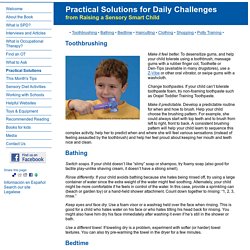
To desensitize gums, and help your child tolerate using a toothbrush, massage gums with a rubber finger cot, Toothette or Den-Tips (available in many drugstores), use a Z-Vibe or other oral vibrator, or swipe gums with a washcloth. Change toothpastes. If your child can’t tolerate toothpaste foam, try non-foaming toothpaste such as Orajel Toddler Training Toothpaste. Make it predictable. Bathing Switch soaps. Rinse differently. Keep eyes and face dry. Use a different towel. Bedtime Calm with deep pressure. Lights out-or not. Quiet time. Haircutting. Welcome - SensorySmarts. Sensational Brain — BrainWorks Sensory Diet Creator Tool. What is a Sensory Diet? Sensory Seeker Solutions for Older Children Who Need to Chew. Developing & Cultivating Skills Through Sensory Play . Child Development. Children (and adults) learn best and retain the most information when they engage their senses.
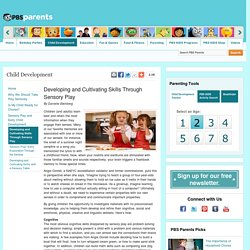
Many of our favorite memories are associated with one or more of our senses: for instance, the smell of a summer night campfire or a song you memorized the lyrics to with a childhood friend. Now, when your nostrils and eardrums are stimulated with those familiar smells and sounds respectively, your brain triggers a flashback memory to those special times. Angie Dorrell, a NAEYC accreditation validator and former commissioner, puts this in perspective when she says, “Imagine trying to teach a group of four-year-olds about melting without allowing them to hold an ice cube as it melts in their hands or to watch cheese on bread in the microwave. As a grownup, imagine learning how to use a computer without actually sitting in front of a computer!” Linguistic Children can’t define parts of language until they’ve experienced the true meaning of the word.
Touch Sight Hearing Smell. The Olfactory System. The Olfactory System, or sense of smell, which senses and processes odors, is one of the oldest and most vital parts of the brain.
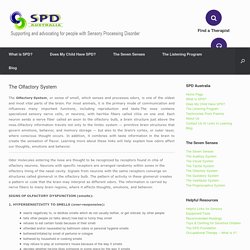
For most animals, it is the primary mode of communication and influences many important functions, including reproduction and taste.The nose contains specialized sensory nerve cells, or neurons, with hairlike fibers called clilia on one end. Each neuron sends a nerve fiber called an axon to the olfactory bulb, a brain structure just above the nose.Olfactory information travels not only to the limbic system — primitive brain structures that govern emotions, behavior, and memory storage — but also to the brain’s cortex, or outer layer, where conscious thought occurs. In addition, it combines with taste information in the brain to create the sensation of flavor.
Learning more about these links will help explain how odors affect our thoughts, emotions and behavior. SIGNS OF OLFACTORY DYSFUNCTION (smells): 1. 2. SPD Australia. Click the play button to listen to an interview with Tracey Butler – Director of Links To Learning, Michelle Cloete from Kids Matters Occupational Therapy and Emma Rushbrooke Clinical Director of Hear and Say.
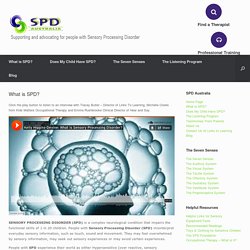
SENSORY PROCESSING DISORDER (SPD) is a complex neurological condition that impairs the functional skills of 1 in 20 children. Sensory Shop. Tip_Sheet_-_Using_Sensory_Toys_to_Improve_Learning_and_Behaviour. Developing & Cultivating Skills Through Sensory Play . Child Development. Sensory Play: Early Exploration Through the Senses . Child Development & Early Childhood Development Advice . PBS Parents.
Have you ever witnessed a child’s bad mood disintegrate with a splash in the bath?
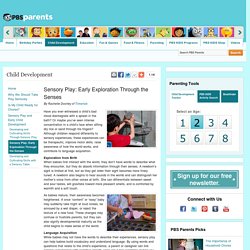
Or maybe you’ve seen intense concentration in a child’s face when sifting dry rice or sand through his fingers? Although children respond differently to sensory experiences, these experiences can be therapeutic, improve motor skills, raise awareness of how the world works, and contribute to language acquisition. Exploration from Birth When babies first interact with the world, they don’t have words to describe what they encounter, but they do absorb information through their senses. A newborn’s sight is limited at first, but as they get older their sight becomes more finely tuned.
A newborn also begins to hear sounds in the womb and can distinguish her mother’s voice from other voices at birth. As babies mature, their awareness becomes heightened. Language Acquisition While babies may not have the words to describe their experiences, sensory play can help babies build vocabulary and understand language. The_Importance_of_Sensory_Experience. ExtVol25No5_low.